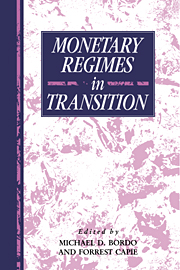Book contents
- Frontmatter
- Contents
- List of figures
- List of tables
- List of contributors
- 1 Introduction
- Part I Commodity money standards in transition
- Part II Successful and unsuccessful adherence to the gold standard
- Part III Wartime upheaval and postwar stabilization
- 8 British and French finance during the Napoleonic Wars
- 9 Interpreting a change in monetary policy regimes: a reappraisal of the first Hungarian hyperinflation and stabilization, 1921–28
- 10 Halting inflation in Italy and France after the Second World War
- 11 The rise and fall of credit controls: the case of Sweden, 1939–89
- Part IV Perspectives on monetary regimes
- Index
11 - The rise and fall of credit controls: the case of Sweden, 1939–89
Published online by Cambridge University Press: 05 May 2010
- Frontmatter
- Contents
- List of figures
- List of tables
- List of contributors
- 1 Introduction
- Part I Commodity money standards in transition
- Part II Successful and unsuccessful adherence to the gold standard
- Part III Wartime upheaval and postwar stabilization
- 8 British and French finance during the Napoleonic Wars
- 9 Interpreting a change in monetary policy regimes: a reappraisal of the first Hungarian hyperinflation and stabilization, 1921–28
- 10 Halting inflation in Italy and France after the Second World War
- 11 The rise and fall of credit controls: the case of Sweden, 1939–89
- Part IV Perspectives on monetary regimes
- Index
Summary
Introduction
Why do economic policies change? Why do policy makers replace one policy regime with another? An answer to this question is provided here by using Swedish central bank policy over the past 50 years as a case study. Swedish authorities moved in the 1940s and 1950s from a traditional monetary policy based on open market operations, discount changes and unregulated international flows of money and capital to a policy based on foreign exchange and capital controls, central allocation of credit flows of all financial institutions and regulation of interest rates. Then in the 1980s these controls were gradually dismantled and Sweden returned to a monetary policy regime similar in several ways to that which had prevailed before the outbreak of the Second World War.
In short, Swedish monetary policy from 1939 to 1989 can be summarized as a process of financial regulation which prevented financial markets from functioning “freely,” replacing them with centrally-given orders, followed eventually by a process of financial deregulation re-establishing previously fossilized markets or establishing markets for new financial instruments; hence the title for this chapter: the rise and fall of credit controls. This change in policy regime encompasses not only the choice of monetary instruments in a narrow sense, it involves two different sets of rules of behavior for all decision making units in the Swedish economy: the central bank (the Riksbank), the government, the commercial banks, and other financial institutions, as well as private firms and households.
This chapter examines first the transition from a monetary regime based on market incentives to a monetary regime based on bureaucratic controls, and then back again to a regime based on market incentives.
Information
- Type
- Chapter
- Information
- Monetary Regimes in Transition , pp. 346 - 370Publisher: Cambridge University PressPrint publication year: 1993
Accessibility standard: Unknown
Why this information is here
This section outlines the accessibility features of this content - including support for screen readers, full keyboard navigation and high-contrast display options. This may not be relevant for you.Accessibility Information
- 11
- Cited by
